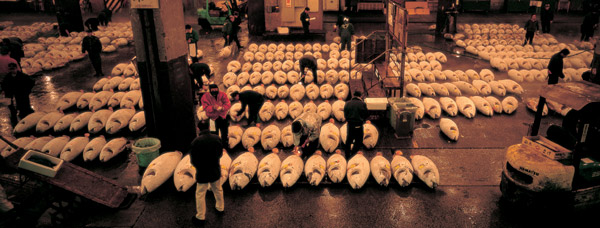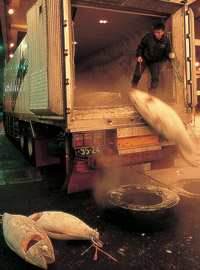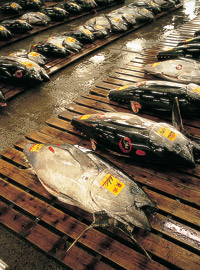 |
|
NIPPONIA No.21 June 15, 2002
|
|
Special Feature*
From Ocean to Tabletop via Tokyo's Tsukiji Market
Tokyo's Tsukiji Market is a treasure house of food, handling all kinds of fresh produce, from seafood to vegetables to meat. The market is said to be first in the world in terms of floor area, sales receipts, volume handled, and number of people and vehicles. The market owes its fame to fish. Here we look at the market and its fish—said to be the best in the world in quality and quantity.
Written by Takahashi Hidemine, Photos by Akagi Koichi

Frozen tuna waiting to be auctioned off. They have arrived here from the seas near Japan and oceans all over the world, from places like Sri Lanka, Tunisia, Spain and Taiwan.

|
Tsukiji Market is only about a 15-minute walk from Ginza in central Tokyo. Every day here, about 450 types of fish and shellfish, weighing a total of 2,300 tons, get shipped from the seas around Japan—actually, from around the world. The market is noisy, with trucks and 3-wheeled vehicles called "turrets" bustling about carrying fish, and auctioneers shouting. Tsukiji Market is Japan's treasure house of food. But be careful—it's so crowded here and everyone's so busy that you could get hurt if you don't keep your wits about you.
The fish and shellfish arrive load after load every night, starting around 11 o'clock. Almost all of it comes by truck, though some boats unload at wharves behind the market. Once unloaded, it all passes into the hands of seven wholesale companies occupying space in the market. They have already agreed to sell the fishing companies' catch. The hard-and-fast rule here is Sokujitsu jojo, zenryo hanbai, which means that all seafood is to be auctioned off the day it is unloaded. This guarantees the fishermen a cash income.
It's 4:40 a.m. and the bell rings. In different parts of the market, licensed auctioneers working for the wholesalers begin calling for bids from middlemen. The middlemen have a total of 929 shops in the market. Each auctioneer has a certain type of fish to sell, and the middlemen buy what they plan to sell to retailers.
The auctioneers want the highest price possible, of course, and they have their own ways to get everyone in a "buying" frame of mind. Maybe they passed the word before the auction that they had special items for sale. Or maybe, after their auction starts, their bodies go into gyrations and their voices sing out fish numbers as if chanting a Buddhist prayer. Only the buyers and auctioneers themselves understand what they are saying. Some auctioneers—perhaps the most talented—use the rhythm of their bodies and voices to get the middlemen in the mood to buy. The buyers join in the rhythm, raising fingers at certain moments to indicate what they are willing to pay. Each lot gets sold in less than ten seconds, and each auction ends in about five minutes, although this can vary depending on the amount of fish for sale. 
|
 |


Tuna unloaded from trucks are weighed, tagged to indicate where they were caught, then laid out for auction. Highly visible red markings are placed on the skin to show flaws.
|
 |
 |
 |

  |
|
 |